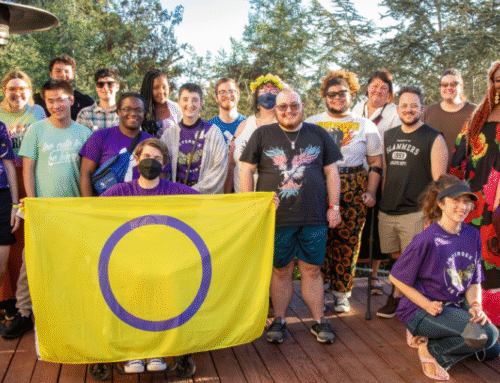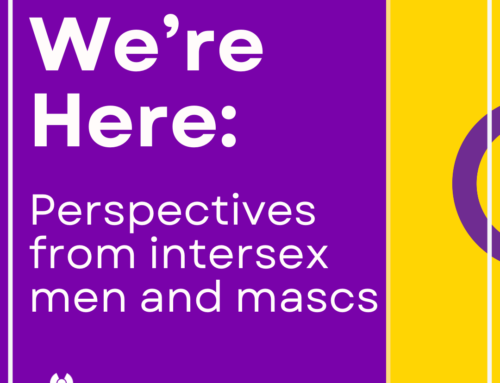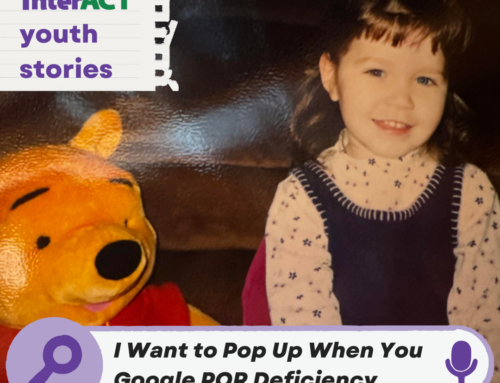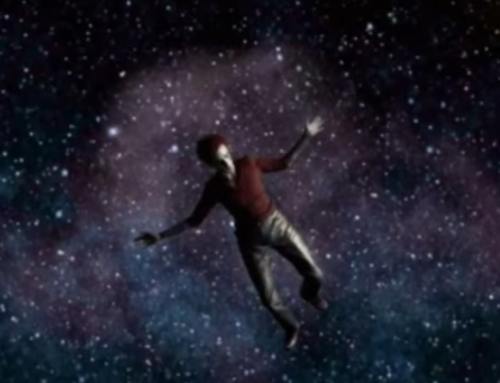A Conversation with David Strachan, Intersex and Non-binary Pioneer
by Hans Lindahl, interACT Member
 I sat down with David Cameron Strachan to reflect on intersex and LGBTQ history, the meaning of “non-binary” gender, and a recent court victory—The San Francisco Superior Court granted David’s petition for non-binary gender markers** last Wednesday. He is now the 5th legally non-binary person in California! David has been an intersex activist for over 20 years. He enjoys coffee cakes and stands seven feet tall in shoes.
I sat down with David Cameron Strachan to reflect on intersex and LGBTQ history, the meaning of “non-binary” gender, and a recent court victory—The San Francisco Superior Court granted David’s petition for non-binary gender markers** last Wednesday. He is now the 5th legally non-binary person in California! David has been an intersex activist for over 20 years. He enjoys coffee cakes and stands seven feet tall in shoes.
I thought we’d start off with your own story: how you found out you were intersex. About your background, your journey of sex and gender.
When I was 13 I didn’t develop like other boys. I was raised a boy. My body didn’t develop, and my mother wanted to look at my genitals. She was concerned. I was taken to the family doctor. The doctor took a look at me, poked and prodded—mind you this was in 1960, so they didn’t have as much knowledge about sex chromosomes—and he didn’t do any tests or anything. He said, “don’t worry, Mrs. Strachan. Your son will grow up normal and you’ll be able to have grandchildren.” That’s what they told my mother.
When I was in Thailand in my 20’s, I was engaged to be married to a woman. She was having trouble with birth control. I remembered my sophomore biology textbook, which said “giants are usually sterile.” Well, no one’s ever called me a giant, but I’m always the tallest person everywhere I go. I went and had a semen analysis in Thailand, and it came back that I didn’t have any sperm. I thought, “Well, I guess I am a giant!”
When I had health insurance and was living in San Jose, CA I went to Kaiser Hospital’s infertility clinic. They told me that I had Klinefelter’s Syndrome and XXY sex chromosomes. I was sterile. They offered me testicular implants and breast reduction surgery, and I said, “no way.”
It wasn’t until 1994 when Dr. Susan Stryker was teaching a class at Harvey Milk Institute. She told me I needed to meet Cheryl Chase, who had started as group called the Intersex Society of North America. And I’d never heard that word before, intersex. I contacted Cheryl and we talked on the phone. She invited me to a support group meeting. I told her what I’d been diagnosed as, and she looked at me said, “that’s intersex!”
How did you feel about the word “Intersex?” Did you have any feelings when you first heard it?
I’d never heard the word. It really never came into the lexicon, I think, until Cheryl Chase put it out there in about 1993. The term made sense to me because I felt caught between my male and female sides. Most people think it’s just this way or that way, but it’s not for a lot of us.
So you met with Cheryl Chase, founder of the ISNA. At that point, how old were you?
In 1995 I was 48.
I would go to those ISNA meetings, and Cheryl really needed help. She was swamped by answering letters. I didn’t know anything about a computer. I didn’t even have one. Cheryl had been in Japan—I think she got her medical records. And she was devastated that her parents didn’t tell her about her intersex status. If you’ve seen the movie Intersexion, she talks a lot about it. In that movie she goes by Bo Laurent. Originally the film was made for New Zealand television. Grant Lahood, the videographer, decided to make a longer film festival version. The first time I saw it I was horrified because the extra part that they included is where I outed myself as having HIV and AIDS. Psychologically, to see that on the big screen, especially in your own town, when you want to keep that information quiet… I was a little freaked out, but I’ve made peace with it.
So I became Cheryl’s first volunteer. She had a P.O. box up in Diamond Heights, in the hills of San Francisco. Peter, my husband, is a bicyclist, and he would go up to the mailbox, pick up the mail, bring it home to me, then I would take it down to the office and we’d sort through it.
So in its earliest days, was ISNA’s work mostly just responding to people who were looking for answers?
Pretty much. And there were a lot of people in prison who would write to us. I don’t know if they were intersex or transgender.
Some people might never get to know, right?
Yeah, exactly.
Cheryl would be on her headset talking to people all over the world, and I’d be sitting with envelopes and writing paper, which I loved. Cheryl had so many books. Because I’m a carpenter, I built bookshelves around the periphery of the wall so she could put all her books up on display.
Was it even that there was that much literature about intersex?
Well, it was more medical journals. When I first met Cheryl, she showed me a medical text with a picture of 9 people with Klinefelter’s Syndrome standing naked in a line with their eyes blacked out. I could look at any one of them and say, “that’s my body.” That could have been me.*
* Footnote: These types of photos were commonly taken for medical textbooks without their subjects’ consent. For many intersex people, they are harmful and stigmatizing.
When I was diagnosed, my endocrinologist, without my informed consent, put me on massive doses of testosterone and didn’t tell me what would happen.
That’s a lie that a lot of intersex people go through, right? Did the endocrinologist come up with a lie as to why you needed that medication?
When I first went to him my only complaint was a low sex drive, but when I look back on it now, the low sex drive… my girlfriends at the time just said I didn’t have enough energy to pelvically thrust. (laughing) That was my main complaint, that my sex drive was lower. But when I was with men, I had no problems.
So it could be something else then.
Back in the 70’s is when I found out I had Klinefelter’s. Just three years earlier, the medical DSM had just removed homosexuality. I’m sure that all the doctors still had this narrow view of man = male, female = woman.
Yeah, and I’m sure gender plays into endocrinology so hard. Especially with masculinity being what it is, sex drive is The Most Important Thing.
I really wish that they’d started me on a smaller dose of testosterone, just to see how it reacted in my body. I have had so many medical problems since, because of the high doses.
I still take it about every 2 ½ weeks, and my partner has to inject it. Originally I had a little mustache. But then I started growing a beard. And then it just kept growing, growing everywhere. (laughing) By 29 I already had a feeling about my body, about being at peace with it. I liked it.
It seems like you experienced the secrecy, lies, and shame that a lot of intersex people were subjected to. I have my perspective on what it’s like to get an intersex diagnosis as a young person in the 2000’s. But in the 1970’s, after John Money? What was the climate like finding out then?
It permeated everything after the twins case. Dr. John Money kept purporting that it was a great success when it wasn’t. Geniuses are often not very good. He was a psychologist, not a medical doctor. That’s what blows me away.
But it sounds like by the time you had met Cheryl Chase, and the time you were through your late 20’s, you said you started to feel comfortable in the body that you had.
I had a girlfriend once. We would put our boobs up next to each other and say, “look, twins!” (laughter) And I’ve been taking so much testosterone, because I thought the doctor was God. That it was something I had to do.
No one thinks to question doctors, unfortunately.
I went to massage school up in the Santa Cruz mountains. They used to run around naked. Just a really happy, fun, great time in your 30’s. The 70’s were wonderful years. Then AIDS hit. But nobody knew about it.
What happened with AIDS in your life, in San Francisco?
You don’t want to know. It was a horrible time here. I lost so many friends, neighbors, coworkers. People were walking around with crutches. We never thought we’d live to be 50, let alone 70. And I know two people who were intersex, that have my condition, and died from AIDS.
To watch them die, and to go to hospices…. It was during the Reagan administration. He wouldn’t even mention AIDS by name.
We touched on AIDS and coming of age in a different time, feeling comfortable with gender and sexuality. Intersex people have that added component of sex to deal with. Do you identify as non-binary in your sex and/or gender?
I’m still trying to figure out what non-binary means to me.
Maybe it just means not male and not female. It means “other.” And to be legally recognized as other is a good thing. I prefer the “other” to be non-binary. But I feel like on identity documents, when they ask male/female, they should have an “other” and a fill in the blank.
It is kind of silly. Last week I had to buy an airline ticket, and they asked me: gender, male or female? Why?
Yeah, why?! The weird thing is, with the legal gender marker, all of our documents say “sex.” And sex and gender are totally different.
Exactly. I don’t think that’s quite mainstream knowledge yet. I think we’re making slow progress, and you’re at the forefront of that.
As an intersex person, that erasure is very common, right? Doctors, by acting quickly with things like surgery or hormones, they’re making the decision to erase or correct intersex people. They check “male” or “female” for us.
Right.
Changing gender markers on legal documents could be a step to combat the erasure of intersex and non-binary identities.
Well I think all of us have lots of different identities. I thought it was your sex that you have to change legally, but that field on some documents is actually referred to incorrectly as gender. Gender is socially constructed. To the government, gender and sex are interchangeable.
You don’t have to be intersex to identify your legal gender as non-binary. Not all intersex people are non-binary. Anyone who identifies as non-binary can do so, as long as a judge grants the petition. You have to pay $450 at the court. At the same time you can have your name changed for the same cost.
Toby Adams is the attorney who I’ve been working with since 2011. I told Toby that my passport needed to be redone in 2012. That year came and went. I had to check the “male” box, unfortunately. I had my psychiatrist and my medical doctor write letters asking the State Department to change my documents to intersex. But I was doing it backwards, because I didn’t know that it’s your gender that you change legally, not your sex.
Your petition was granted without a court date. Congratulations! I know you had originally planned to host a rally after the court date.
I had my outfit all picked out and everything! I have these really lovely red corduroy pants. I have a green t-shirt that I’m going to wear under a black long sleeved shirt, and I have rainbow suspenders to hook onto my pants. I have this black muslim cloak that I bought online, and my friend Mani Bruce Mitchell gave me a scarf. I want part of her with me when I go there. Depending on the weather, I was thinking of getting some sort of a hat with a little feather on it. (laughter) And I have to take my cane with with me. My balance is sort of off.
I think you’re going to knock ‘em dead.
I hope so. If they granted it, what I was going to do was open up my black shirt to show a t-shirt that says “non-binary” and has a rainbow flag over it.
San Francisco is probably the best possible place to do something like this.
That’s a direct quote from Hida Viloria in Intersexion! I’ve been doing intersex activism for 20 years. It’s hard to believe.
It’s so important. I was 15 when I found out that I was intersex. Luckily I had the internet, so I could Google people and immediately find connection. My first support group conference happened to be in Chicago when I was 15, so I got to go right away. Despite following Pidgeon Pagonis and Georgiann Davis—those are two of our prominent intersex voices out of Chicago—I never really knew what to study about intersex activism. Who was doing this kind of work before? What is the history of intersex activism in North America?
… the first question that I have in that vein is: how did you go from finding out about this part of yourself, to wanting to become an activist? Did you feel like you had a responsibility? Was that a hard transition to make?
No! It was very empowering. Actually, I had an essay inside of me that I wanted to get out, and I was able to get it out. I called it “Caught Between: An Essay on Intersexuality.” At first it was published in Chrysalis, a magazine, along with a bunch of others’ writings. It was for people with “transgressive identities.”
Do you know who Dr. Alice Dreger is? She wanted diverse intersex people to write their stories, to publish in book form. I made an addendum to my story and sent it in with two pictures: one of me naked from the waist up prior to testosterone therapy, the other 20 years later. You wouldn’t believe it’s the same person. Most people can’t wrap their head around it.
I agree on the subject of feeling energized by wanting to share this experience, feeling like the transition to activism wasn’t hard. Maybe now it’s easier with the internet.
Hida Viloria and I co-led an intersex support group for two years. We had a lot of transgender people coming in.* I can’t be the gender police. I can only go by what someone tells me.
* Footnote: Some intersex people are also transgender. Some transgender people may seek out information to see if they are intersex (or even claim that they are intersex if they are not) because of society’s unfortunate belief that a biological basis for variation is more “valid.” interACT hopes to see a world where all types of sex and gender diversity are embraced.

So do you also identify as non-binary?
I do!
Good to meet you!
Good to meet you! (laughter)
It’s a very new thing for me, too. I’ve always been very proud and very open about being intersex, but I think there has always been a dysphoria, a feeling that I’m caught in the middle. Maybe this is similar to what you described. I’ve always felt like Peter Pan: this person eternally caught in the middle. I didn’t hear the term until about a year ago. Coming here to San Francisco is really where I started to learn the term and start thinking about what it meant. I realized, “oh my goodness, I think those might be right for me, too.”
Congratulations! That’s a wonderful place to be.
Thank you! I have several nonbinary friends, most of whom are not intersex, but some of whom are. In my experience that’s been a bit of a divide—maybe a generational divide. That some people view intersex as an identity, and think it should be part of LGBT, that we should be activists and fight for this. Some people want to be more quiet about it – e.g. “it’s a part of me, it doesn’t define who I am, which is a normal woman or man.”
Well that’s safe. And that’s why I generally dress the way I do, because I’m seven feet tall.
Again, as we mentioned, San Francisco is totally the best case scenario. But safety is completely a concern for anyone who wants to be self expressive.
My friend Mani Bruce Mitchell, from New Zealand, she was born a hermaphrodite—that’s how they called her. She’s been wanting to get her birth certificate changed, but she says with traveling as much as she does it would be very dangerous. Thank God for San Francisco.
I’ve donated most of my intersex archives to the Hormel LGBTQIA Center. There’s a book that Mani and I labeled together called “Yellow for Hermaphrodites.” I’ve had all my activism work videotaped because I’ve felt this needs to be archived. “Yellow for Hermaphrodites” was Mani’s story, the title of her movie. An album that I donated last January has lots and lots of information about intersex history. It’s 134 pages.
One of the most important questions: what advice would you give to young Intersex people? Particularly those who want to be activists?
Well I think interACT is a great place to start. Hopefully interACT will blossom out into different communities.
Also, to be happy with themselves and take care of themselves. Honor their inner being. Honor that inner spark that all of us really are.
Respect your boundaries. I’m always telling people not to overextend. And feel your emotions. It’s really important to feel one’s emotions: if you’re happy, sad, angry, get it out of your body! Don’t store it inside because it will make you sick. As an intersex elder … (laughter)
I think that’s something people learn over time: how to be more in touch with your body and your emotions. Learning what you need to take care of yourself, and finding your people.
In the San Francisco Bay area I know seven people with Klinefelter’s. Most people think there’s only these sex chromosomes or those, and they only belong to this sex or that sex, and that’s not true!
Would you say that people with Klinefelter’s don’t usually identify as intersex?
Some don’t.
We all have our different identities, how we feel about ourselves and our bodies. “Intersex” is a word that just resonated with me when I heard it, and now non-binary… that’s an exciting one too! I’m non-binary in my sex as well as my gender.
That’s a breath of fresh air for me, too!
Yaaaaay! (laughter) My husband, Peter, and I were part of a group called the Guardian Group. We’ve helped LGBTI people from the Middle East, Russia, Africa, who are trying to escape persecution. We do it because we have a home, and most people in San Francisco have a bedroom if they’re lucky.
It’s a weird time to be in San Francisco. As someone who’s lived here longer term, how do you feel about everything that’s going on in the city?
I’m overwhelmed by all the building. Businesses come and go. I feel like I’ve lived in five different San Franciscos in the 37 years I’ve been here.
The first few years I was just here, having a good time. I met my honey in ‘78. And then the AIDS thing hit, which was very scary in the 80’s. I found out in ‘86 that I was positive. They came out with the life saving drugs in ‘96. ActUP and a lot of other AIDS groups, gays and lesbians, were fighting drug companies and the government, having die-ins and all kinds of protests. They closed Golden Gate Bridge once by laying across the street. Once they interrupted the San Francisco Opera. It was really serious stuff that they were doing.
I didn’t participate in that because I was still working. I had my business. I’ve always been a home and garden person. But now my joints are all sore, arthritis in my hips, my wrists hurt. But I’m still here!
I’m glad you’re here.
I’m glad you’re here, too. Thank you so much for meeting with me.
This was a treat! I’ll close with mentioning what’s on your business card.
It’s how tall I am: seven feet in shoes. And underneath it says: please make a donation to:
interACT,
The Intersex & Genderqueer Recognition Project,
Intersex Awareness New Zealand.
Then it has my name:
David Cameron Strachan
Advocate, writer, and peacemaker.”
** The process of legally changing gender or sex on U.S. government documents is complicated, and varies based on one’s age, gender, prior history, and location. The first step can be petitioning a court to receive a court order. This court order is the fuel for a person to go to individual government agencies (e.g. the social security office) to change individual documents such as a passport or driver’s license. The Intersex & Genderqueer Recognition Project offers counsel on case-by-case steps.






